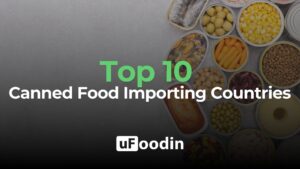
Top 10 Candy Brands
Candy has long held a special place in human culture, symbolizing indulgence, celebration, and nostalgia. The global candy market was valued at approximately $223 billion in 2023, driven by growing demand across various segments, including chocolates, gummies, and hard candies. The industry is projected to grow at a CAGR of 3.7%, reaching a market size of $287 billion by 2030, fueled by innovation in product offerings, expanding middle-class populations in emerging markets, and the rising popularity of premium and functional confections.
North America and Europe remain dominant in candy consumption, collectively accounting for nearly 50% of the global market, while the Asia-Pacific region is experiencing significant growth due to increasing disposable incomes and urbanization. Beyond taste, the candy industry is witnessing a transformation as consumers seek healthier, sustainably produced options. Premiumization and wellness trends are also driving demand for organic, low-sugar, and functional candies, opening new opportunities for growth.
With a rich legacy and dynamic future, candy brands must navigate complex challenges, including health regulations, climate impacts on ingredient sourcing, and evolving consumer expectations. This article explores the Top 10 Candy Brands, their contributions to the global market, and how they are innovating to stay ahead in this competitive industry.

- Mars, Incorporated
- Headquarters: McLean, Virginia, USA
- Why It Stands Out: With iconic brands like Snickers, M&M’s, and Twix, Mars leads the global candy market, consistently innovating to cater to changing consumer preferences.
- Key Innovations: Development of sustainable cocoa sourcing programs and plant-based alternatives for popular products.
- Ferrero Group
- Headquarters: Alba, Italy
- Why It Stands Out: Known for Nutella, Ferrero Rocher, and Kinder products, Ferrero combines premium quality with mass appeal, making it a household name.
- Key Innovations: Focus on transparent supply chains and innovative product formats like bite-sized Ferrero Rocher bars.
- The Hershey Company
- Headquarters: Hershey, Pennsylvania, USA
- Why It Stands Out: A staple in the American candy market, Hershey’s offers beloved classics like Reese’s, KitKat (in the US), and Hershey’s Kisses.
- Key Innovations: Expansion into healthier snack options and low-sugar variants.
- Mondelez International
- Headquarters: Chicago, Illinois, USA
- Why It Stands Out: Mondelez owns leading brands such as Cadbury, Milka, and Toblerone, excelling in both traditional and innovative candy offerings.
- Key Innovations: Introduction of portion-controlled packaging and sustainability-focused “Cocoa Life” program.
- Haribo
- Headquarters: Bonn, Germany
- Why It Stands Out: Haribo revolutionized the gummy candy segment with its Goldbears and remains a global leader in fruit-flavored candies.
- Key Innovations: Expansion into vegan-friendly gummies and sugar-reduced options.
- Nestlé
- Headquarters: Vevey, Switzerland
- Why It Stands Out: While Nestlé has sold some of its confectionery assets in certain markets, it remains a key player with brands like KitKat (outside the US) and Smarties.
- Key Innovations: Development of sugar-reduction technologies and functional confectionery products.
- Lindt & Sprüngli
- Headquarters: Kilchberg, Switzerland
- Why It Stands Out: Known for its premium chocolate offerings, Lindt excels in high-quality, indulgent candy experiences with brands like Lindor and Ghirardelli.
- Key Innovations: Focus on direct-sourced cocoa and expansion of vegan chocolate lines.
- Perfetti Van Melle
- Headquarters: Lainate, Italy, and Amsterdam, Netherlands
- Why It Stands Out: The company is behind globally recognized brands like Mentos, Chupa Chups, and Alpenliebe, excelling in diverse candy categories.
- Key Innovations: Sustainable packaging initiatives and sugar-free product innovations.
- Meiji Co., Ltd.
- Headquarters: Tokyo, Japan
- Why It Stands Out: Meiji is a leading confectionery producer in Asia, known for its rich chocolate products and innovative candy creations.
- Key Innovations: Use of high-quality, locally sourced ingredients and functional confectionery with added health benefits.
- Lotte Confectionery
- Headquarters: Seoul, South Korea
- Why It Stands Out: Lotte is a dominant player in Asia’s candy market, offering a mix of traditional and modern products, including Pepero and Koala’s March.
- Key Innovations: Development of unique flavor profiles tailored to Asian markets and sustainability-focused manufacturing.
Major Trends in the Candy Industry
- Health-Conscious Consumers Drive Product Evolution
The demand for healthier candy options is reshaping the industry. Low-sugar, sugar-free, and organic candies are gaining traction, with these categories expected to grow at a CAGR of 5.2%. Functional candies, such as those infused with vitamins or adaptogens, are also becoming popular, offering indulgence with added health benefits.
- Premiumization of Candy
High-end, artisanal, and gourmet candies are seeing significant growth, especially in developed markets. Consumers are willing to pay a premium for products made with ethically sourced ingredients, unique flavors, and luxurious packaging. Premium chocolates alone now account for over 20% of the global candy market.
- Sustainable Sourcing and Ethical Practices
The industry is under pressure to adopt sustainable practices, particularly in cocoa and sugar sourcing. Companies like Mars and Mondelez have introduced initiatives to ensure fair labor practices, reduce deforestation, and support smallholder farmers. Sustainable packaging, including compostable wrappers, is another key focus area.
- Innovation in Candy Formats
Brands are experimenting with innovative formats, such as plant-based gummies, hybrid snacks (e.g., chocolate-covered nuts), and candies that combine indulgence with functionality. Advances in sugar reduction technologies and natural flavorings are enabling brands to cater to evolving preferences.
- Expansion into Emerging Markets
Emerging economies, particularly in Asia-Pacific, Latin America, and the Middle East, are experiencing rapid growth in candy consumption. Increasing urbanization, rising disposable incomes, and westernization of diets are driving demand in these regions, prompting global brands to expand their presence.
- Growth of Digital and E-commerce Channels
The digital transformation of retail has significantly impacted candy sales. E-commerce platforms and direct-to-consumer channels are growing at a CAGR of 8%, enabling brands to reach a global audience with personalized marketing and subscription services.

Main Challenges in the Candy Industry
- Navigating Health Regulations
Governments worldwide are introducing stricter health regulations, including sugar taxes, advertising restrictions for sugary products, and mandatory nutritional labeling. These policies are forcing companies to reformulate products and rethink marketing strategies, especially for products aimed at children.
- Climate Impacts on Raw Materials
The production of key candy ingredients, such as cocoa, sugar, and nuts, is highly vulnerable to climate change. Erratic weather patterns, droughts, and deforestation are reducing yields and driving up costs, particularly in cocoa-producing regions like West Africa.
- Balancing Tradition and Innovation
While innovation is critical to attracting new consumers, brands must also retain their core audience by maintaining the essence of their classic products. Striking this balance between tradition and modernity is a constant challenge for long-standing candy makers.
- Rising Costs and Supply Chain Disruptions
The global supply chain crisis has impacted candy production, with rising transportation costs, raw material shortages, and increased labor costs affecting profitability. Smaller brands, in particular, struggle to absorb these costs compared to their larger counterparts.
- Increasing Competition from Healthy Snacks
As consumers shift toward healthier eating habits, candy faces growing competition from alternative snacks like protein bars, dried fruits, and nut-based products. These substitutes are particularly appealing to health-conscious millennials and Gen Z.
- Counterfeit and Substandard Products
The proliferation of counterfeit and substandard candy in markets, particularly in emerging economies, affects brand reputation and consumer trust. Ensuring product authenticity and quality is an ongoing battle for global candy companies.
The Top 10 Candy Brands are more than manufacturers of sweet treats; they are pioneers in innovation, sustainability, and meeting the diverse tastes of a global audience. From Mars’ efforts in ethical cocoa sourcing to Haribo’s expansion into plant-based gummies, these companies exemplify resilience and adaptability in an ever-changing market.
Platforms like uFoodin offer candy producers and distributors a unique opportunity to connect with global buyers, retailers, and ingredient suppliers. Beyond showcasing products, uFoodin fosters partnerships that promote sustainability and innovation. For example, brands can collaborate with suppliers of organic or alternative ingredients, ensuring their offerings align with the latest consumer trends.
Moreover, the platform supports smaller producers aiming to scale their operations and reach new markets, especially in emerging regions where candy consumption is on the rise. By leveraging tools for e-commerce integration and data-driven insights, producers can better understand market demands and respond effectively.
As the candy industry evolves, its leaders will be defined by their ability to adapt to changing consumer expectations, embrace sustainability, and leverage technological advancements. These top brands continue to shape the future of confectionery, proving that indulgence can coexist with responsibility and innovation.
uFoodin Editorial Team
Bibliography
- Statista: Global Candy Market Trends and Projections
- Fortune Business Insights: Innovations in the Confectionery Industry
- FAO (Food and Agriculture Organization): Cocoa and Sugar Production Data
- Company Websites: Mars, Ferrero, Mondelez







